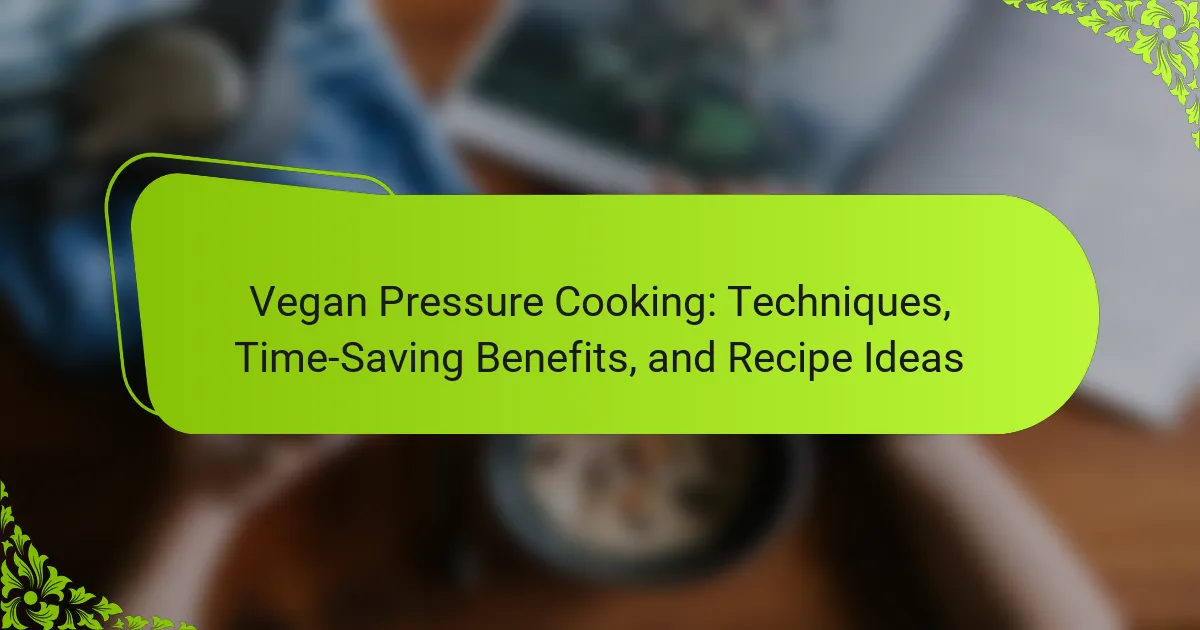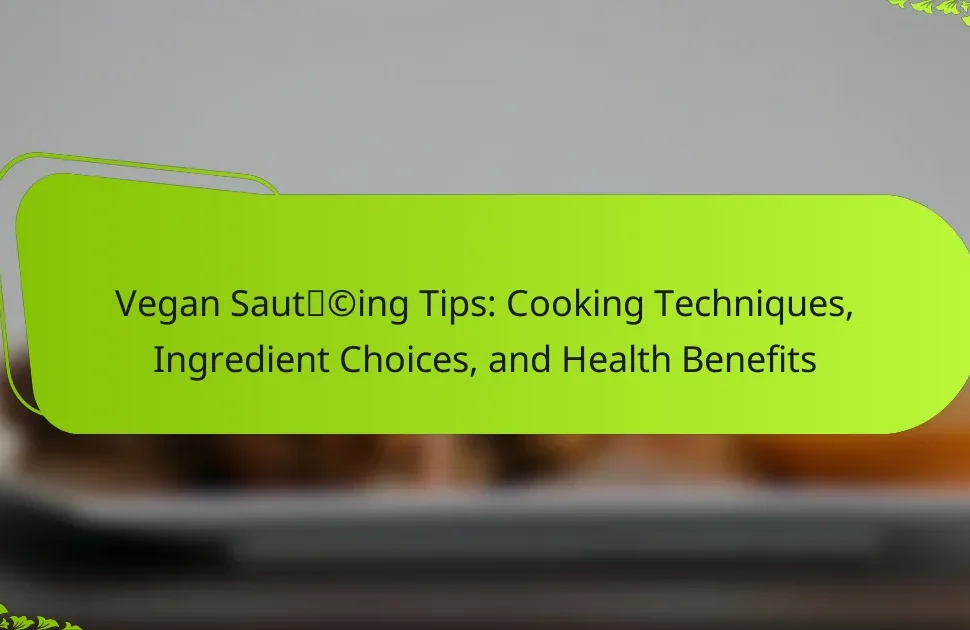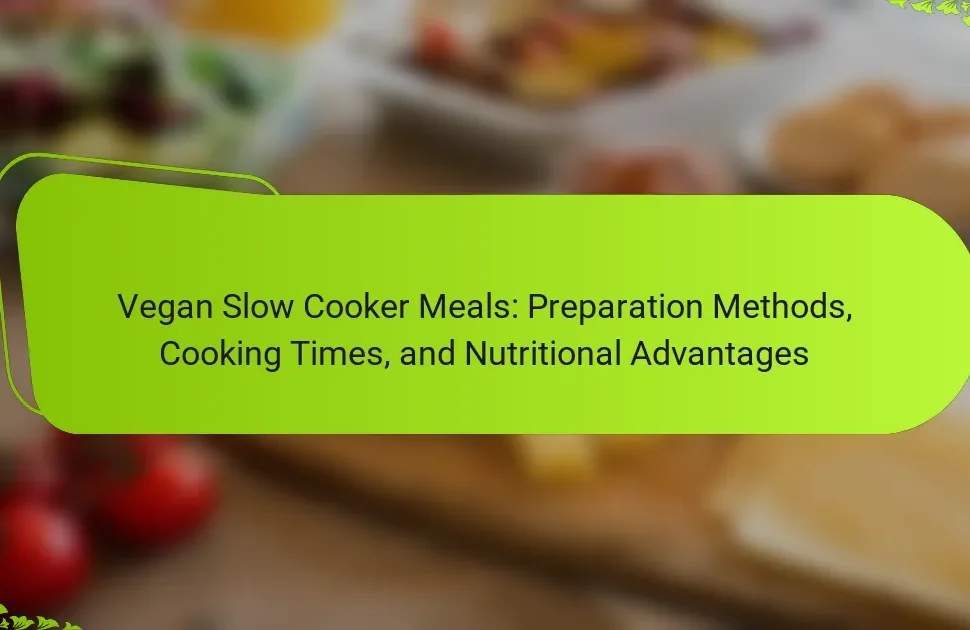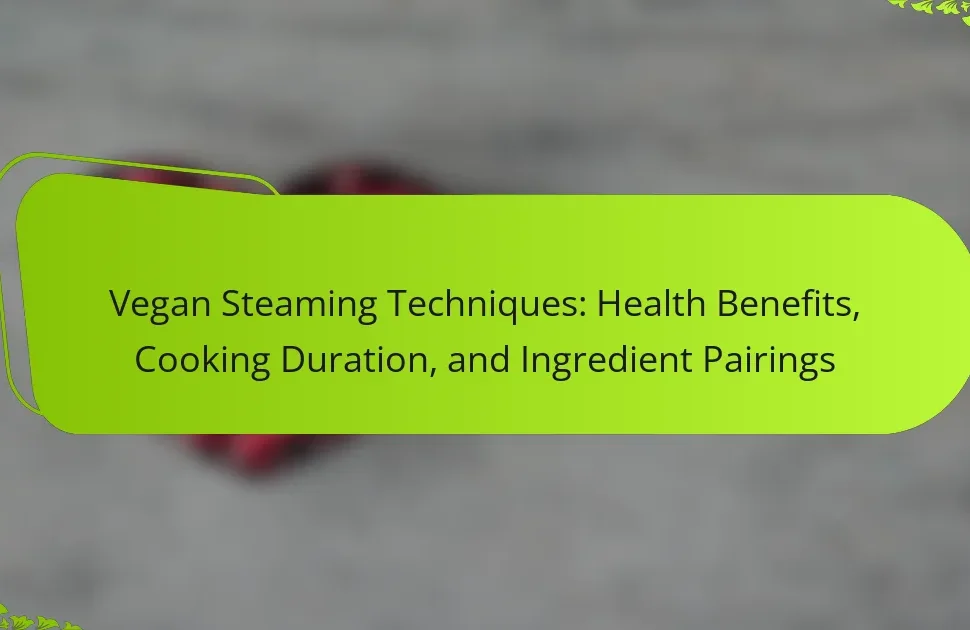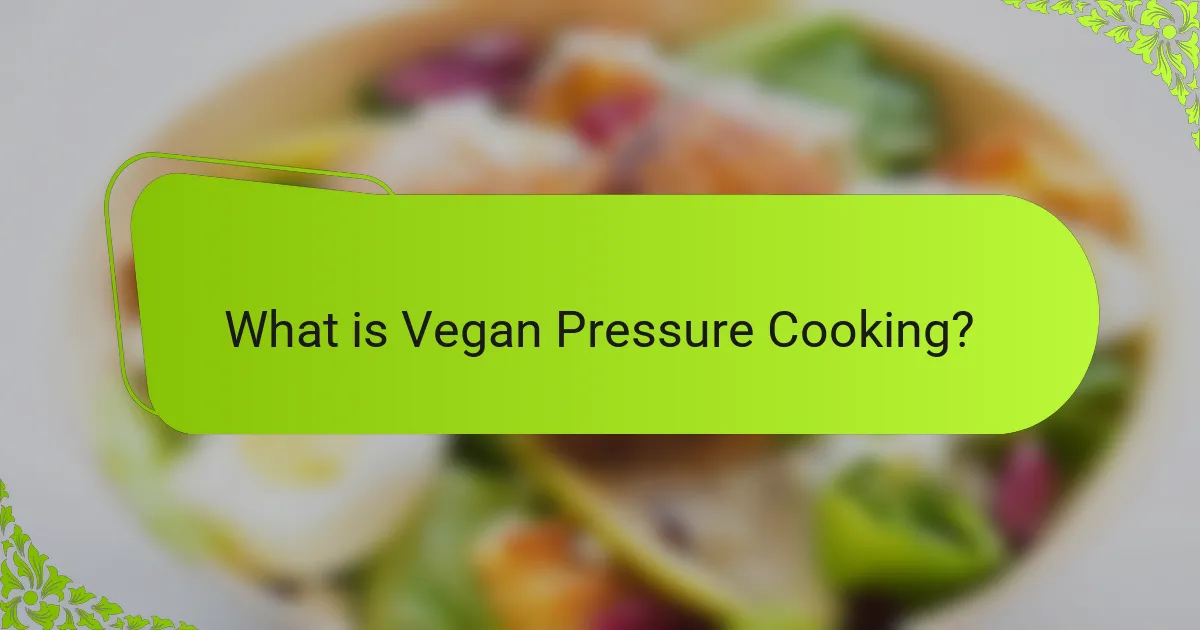
What is Vegan Pressure Cooking?
Vegan pressure cooking is a method of cooking plant-based foods using a pressure cooker. This technique utilizes steam and high pressure to cook food quickly and efficiently. It retains nutrients and enhances flavors in vegetables, grains, and legumes. Pressure cooking can significantly reduce cooking times, often by up to 70%. For example, beans that typically take hours to cook can be ready in under 30 minutes. This method is particularly beneficial for busy individuals seeking healthy meal options. Additionally, pressure cooking uses less energy compared to traditional cooking methods. The versatility of pressure cookers allows for a wide range of vegan recipes, from soups to stews and even desserts.
How does Vegan Pressure Cooking differ from traditional cooking methods?
Vegan pressure cooking differs from traditional cooking methods primarily in the cooking time and moisture retention. Pressure cooking uses high-pressure steam to cook food quickly, often reducing cooking times by up to 70%. Traditional methods, like boiling or baking, usually take longer and may lead to nutrient loss.
In vegan pressure cooking, legumes and grains can be cooked in a fraction of the time compared to stovetop methods. For example, dried beans that take hours to cook can be ready in 30 minutes in a pressure cooker. This method also preserves flavors and nutrients better due to the sealed environment.
Additionally, pressure cooking requires less water than boiling, which is beneficial for nutrient retention. Traditional cooking often involves more water, leading to potential nutrient leaching. Overall, vegan pressure cooking is an efficient and health-conscious alternative to traditional cooking methods.
What are the basic principles of pressure cooking?
Pressure cooking uses steam and high pressure to cook food quickly. The sealed environment raises the boiling point of water, allowing food to cook faster. This method retains nutrients and flavors better than traditional cooking. Pressure cookers require a specific amount of liquid to generate steam. The pressure inside the cooker builds until it reaches a predetermined level, which is maintained during cooking. Cooking times are significantly reduced, often by up to 70%. Safety mechanisms prevent the cooker from being opened while under pressure. Proper sealing is essential to maintain pressure and ensure efficient cooking.
What makes pressure cooking suitable for vegan diets?
Pressure cooking is suitable for vegan diets due to its ability to retain nutrients in plant-based foods. This cooking method uses high pressure and steam, which cooks food quickly. Quick cooking minimizes nutrient loss, especially for vitamins sensitive to heat and water. Additionally, pressure cooking enhances flavors in legumes and grains, making them more palatable. It also reduces cooking time for tough plant materials, such as beans and whole grains, by up to 70%. This efficiency aligns well with the often time-consuming preparation of vegan meals. Moreover, pressure cooking can soften fibrous vegetables, making them easier to digest. These factors collectively support a nutritious and enjoyable vegan diet.
What are the advantages of using a pressure cooker for vegan meals?
Using a pressure cooker for vegan meals offers several advantages. It significantly reduces cooking time, making meal preparation quicker. For instance, legumes that typically take hours to cook can be ready in under 30 minutes. This efficiency is especially beneficial for busy individuals.
Pressure cooking also enhances flavor retention. The sealed environment locks in moisture and nutrients, resulting in tastier dishes. Studies show that pressure cooking preserves more vitamins compared to traditional methods.
Additionally, it promotes energy efficiency. Pressure cookers use less energy than stovetop cooking, reducing overall energy consumption. This makes them an environmentally friendly choice for preparing vegan meals.
Overall, the advantages of using a pressure cooker include time savings, improved flavor, nutrient preservation, and energy efficiency.
How does pressure cooking save time in meal preparation?
Pressure cooking saves time in meal preparation by cooking food faster than traditional methods. It achieves this by using high pressure to raise the boiling point of water. This allows food to cook at higher temperatures. As a result, meals that typically take hours can be done in minutes. For example, beans that require soaking and several hours of cooking can be ready in under an hour. Studies show that pressure cooking can reduce cooking times by up to 70%. This efficiency makes it ideal for busy individuals seeking quick meal solutions.
What nutritional benefits does pressure cooking provide for vegan foods?
Pressure cooking enhances the nutritional benefits of vegan foods by preserving vitamins and minerals. The high-pressure environment reduces cooking time, minimizing nutrient loss. Studies show that pressure cooking retains more water-soluble vitamins compared to boiling. For example, vitamin C retention in vegetables is significantly higher when pressure cooked. Additionally, legumes cooked under pressure improve digestibility and nutrient absorption. This method also helps in breaking down anti-nutrients, making minerals more bioavailable. Overall, pressure cooking is an effective technique for maximizing the nutritional value of plant-based ingredients.
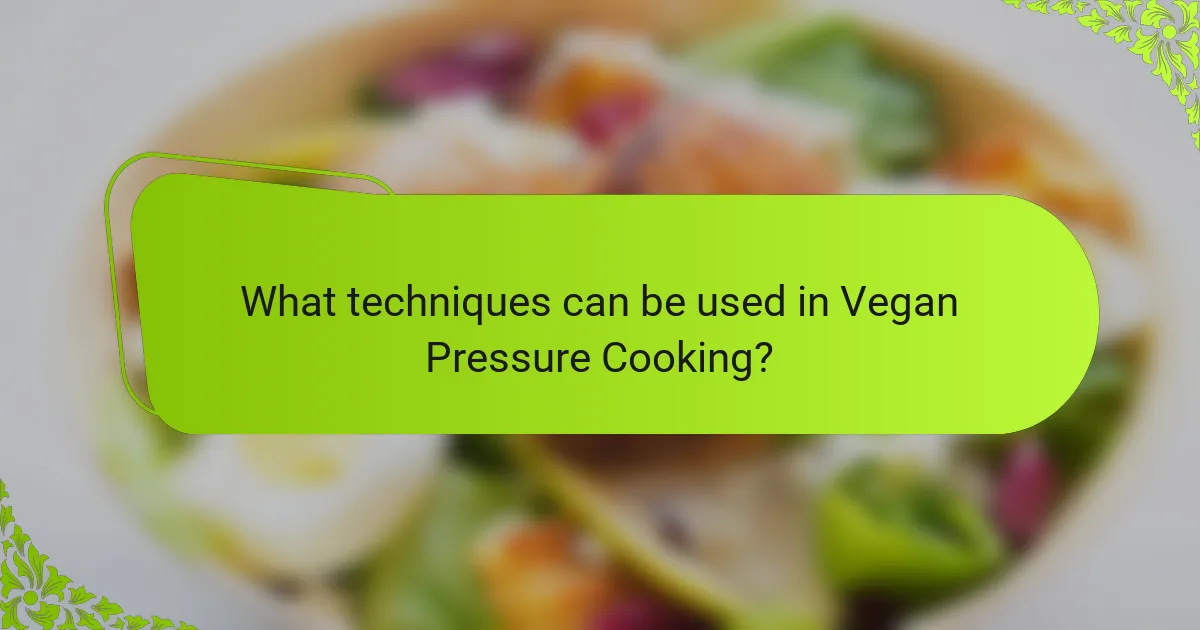
What techniques can be used in Vegan Pressure Cooking?
Vegan pressure cooking employs several techniques to enhance cooking efficiency. Common techniques include sautéing, steaming, and cooking legumes. Sautéing allows for browning vegetables before pressure cooking, enhancing flavor. Steaming is effective for cooking vegetables quickly while retaining nutrients. Cooking legumes in a pressure cooker significantly reduces cooking time, often by 70%. Additionally, layering ingredients can optimize cooking by ensuring even heat distribution. Using a natural release method helps prevent overcooking delicate ingredients. These techniques collectively maximize flavor and nutrition in vegan meals.
How do you properly use a pressure cooker for vegan recipes?
To properly use a pressure cooker for vegan recipes, start by adding the appropriate amount of liquid. Typically, this is at least one cup of water or broth. Next, place your vegan ingredients inside the cooker. Common choices include beans, grains, and vegetables. Secure the lid tightly to ensure no steam escapes during cooking. Set the pressure cooker to the desired cooking time based on the ingredients used. For instance, beans may require 10-15 minutes, while vegetables may need only 5-7 minutes. Once the cooking time is complete, release the pressure safely. This can be done through natural release or quick release methods. Finally, open the lid carefully, as steam will escape. Following these steps ensures effective and safe pressure cooking for vegan meals.
What safety precautions should be taken when pressure cooking?
Always ensure the pressure cooker is properly sealed before use. Inspect the gasket for wear and tear regularly. Do not overfill the pressure cooker; leave space for steam to build. Use the correct heat setting to maintain pressure safely. Release pressure according to the manufacturer’s instructions. Avoid placing your face near the steam release valve. Always use oven mitts when handling the cooker after cooking. Keep children and pets away from the cooking area. These precautions help prevent accidents and ensure safe pressure cooking.
How can you adapt traditional recipes for pressure cooking?
To adapt traditional recipes for pressure cooking, reduce cooking times significantly. Traditional recipes often require longer cooking durations, but pressure cooking can cut these times by up to two-thirds. Adjust the liquid content in the recipe, as pressure cooking requires less liquid than conventional methods. Increase the amount of spices and seasonings to enhance flavors, as pressure cooking can intensify tastes. Monitor the cooking pressure and time closely, as overcooking can lead to undesirable textures. Use a quick-release method for delicate ingredients to prevent mushiness. Finally, consider the size and cut of ingredients; smaller pieces cook faster and more evenly in a pressure cooker.
What are some common cooking methods in pressure cooking?
Common cooking methods in pressure cooking include steaming, sautéing, and braising. Steaming involves cooking food with steam generated by boiling water. This method retains nutrients and moisture. Sautéing allows for browning ingredients before pressure cooking, enhancing flavor. Braising combines both moist and dry heat, ideal for tougher cuts of meat or vegetables. These methods utilize high pressure to cook food faster while preserving taste and texture.
What is the difference between quick release and natural release?
Quick release and natural release are two methods for releasing pressure in a pressure cooker. Quick release involves manually opening the steam valve to release pressure immediately. This method is ideal for foods that cook quickly and need to maintain their texture. Natural release allows the pressure to decrease gradually on its own. This method is better for foods that benefit from continued cooking or softening, like beans or grains. Quick release can lead to splattering, while natural release provides a gentler approach. The choice between them affects cooking results and timing.
How can layering ingredients affect cooking times?
Layering ingredients can significantly affect cooking times in pressure cooking. When ingredients are layered, their cooking times may vary based on their density and moisture content. Denser ingredients, like root vegetables, may require longer cooking times than lighter ingredients, such as leafy greens.
In pressure cooking, steam circulates around the ingredients. If denser items are placed at the bottom and lighter ones on top, it can lead to uneven cooking. This layering can result in the top ingredients being overcooked while the bottom remains undercooked.
To ensure even cooking, it’s essential to consider the cooking times of each ingredient. For example, cooking a layered dish with both beans and vegetables requires adjusting the pressure cooking time to accommodate the longer cooking time of beans.
Additionally, layering can impact the release of steam and pressure buildup. A well-layered dish allows for better steam circulation, which can enhance cooking efficiency. Therefore, understanding how to layer ingredients effectively is crucial for optimizing cooking times in pressure cooking.
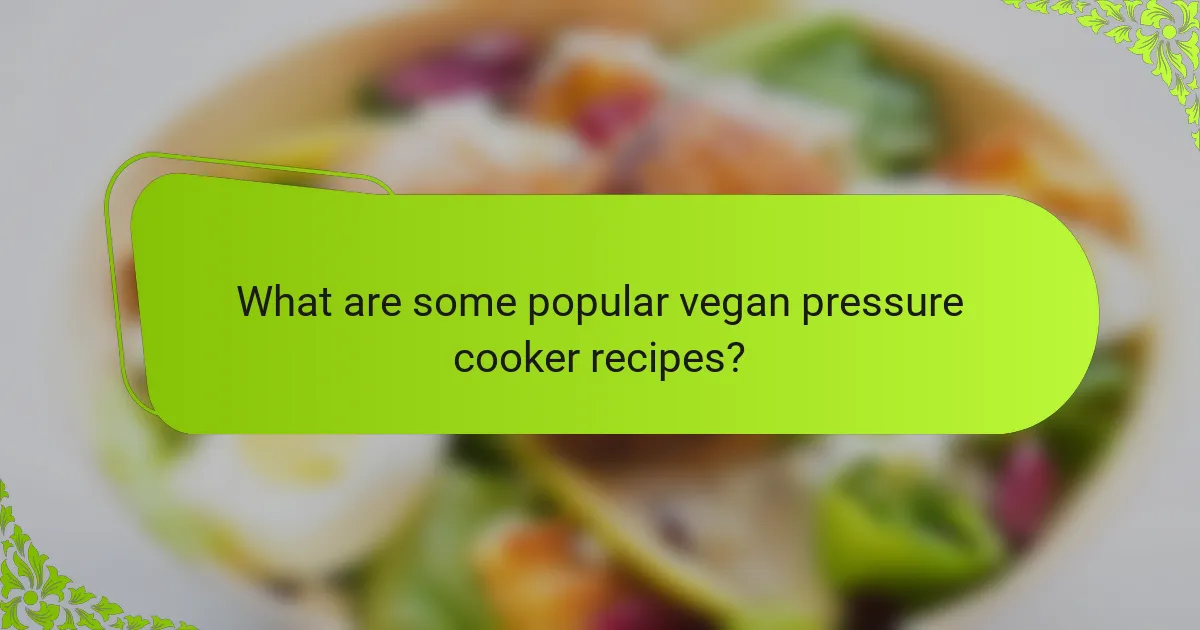
What are some popular vegan pressure cooker recipes?
Popular vegan pressure cooker recipes include lentil soup, chickpea curry, and quinoa pilaf. Lentil soup cooks quickly and is rich in protein. Chickpea curry offers a flavorful, hearty meal. Quinoa pilaf is a versatile side dish that can be customized with various vegetables. Other favorites are black bean chili and vegetable risotto. These recipes save time and retain nutrients. Pressure cooking reduces cooking time significantly, making meal preparation efficient.
What types of dishes can be made using a pressure cooker?
A pressure cooker can be used to make various types of dishes. Common dishes include soups, stews, and curries. It is also effective for cooking grains like rice and quinoa. Legumes such as beans and lentils cook quickly in a pressure cooker. Additionally, it can be used for preparing vegetables and casseroles. Many pressure cooker recipes allow for the infusion of flavors in a shorter time. This method can significantly reduce cooking time compared to traditional methods.
How can you prepare soups and stews in a pressure cooker?
To prepare soups and stews in a pressure cooker, first, gather your ingredients. Chop vegetables and measure out liquids and spices. Next, add oil to the pressure cooker and sauté aromatics like onions and garlic for flavor. Then, add the chopped vegetables, legumes, grains, and liquids to the pot. Secure the lid and ensure the pressure valve is closed. Set the cooker to high pressure and cook for the recommended time, usually between 10 to 30 minutes depending on the recipe. After cooking, allow for natural pressure release or quick release as needed. This method retains nutrients and enhances flavors in your soups and stews.
What are some quick vegan grain recipes for the pressure cooker?
Quinoa pilaf is a quick vegan grain recipe for the pressure cooker. Combine one cup of quinoa with two cups of vegetable broth. Add chopped onions, garlic, and your choice of vegetables. Cook on high pressure for one minute, then allow a natural release.
Brown rice with lentils is another option. Use one cup of brown rice and one cup of lentils with three cups of water. Season with spices like cumin and coriander. Cook on high pressure for 22 minutes, followed by a natural release.
Barley risotto can also be prepared quickly. Mix one cup of pearl barley with four cups of vegetable broth. Stir in mushrooms and peas for flavor. Cook on high pressure for 30 minutes, then perform a quick release.
These recipes highlight the efficiency of pressure cooking for vegan grains. Each dish is nutritious and can be customized with various vegetables and spices.
How can you customize vegan recipes for pressure cooking?
To customize vegan recipes for pressure cooking, adjust cooking times and liquid amounts. Pressure cooking typically requires less time than traditional methods. For most vegetables, reduce cooking time by 50%. Increase liquid by 1/2 to 1 cup to create steam. Use vegetable broth for added flavor. Ensure ingredients are cut uniformly for even cooking. Consider adding spices and herbs to enhance taste. Monitor the release method; quick release is suitable for soft vegetables. These adjustments help maintain texture and flavor while ensuring proper cooking.
What ingredients work best for pressure cooking in vegan recipes?
Beans, lentils, and grains work best for pressure cooking in vegan recipes. These ingredients cook quickly and evenly under high pressure. Beans, such as black beans and chickpeas, soften rapidly, reducing cooking time significantly. Lentils, particularly red and green varieties, also require minimal time in the pressure cooker. Whole grains like quinoa and brown rice benefit from the steam and pressure, cooking to perfection. Vegetables, such as potatoes and carrots, retain their nutrients while cooking quickly. Pressure cooking enhances flavors and reduces the need for added fats or oils. This method is efficient, making it ideal for busy lifestyles.
How can spices and herbs enhance flavor in pressure-cooked vegan meals?
Spices and herbs enhance flavor in pressure-cooked vegan meals by intensifying taste and aroma. The high-pressure environment allows flavors to meld more effectively. Ingredients such as garlic, cumin, and turmeric release their essential oils, creating a rich flavor profile. Fresh herbs like cilantro and basil add brightness and freshness. Dried spices can deepen the overall taste, making dishes more savory. Studies show that herbs and spices can also reduce the need for added salt. This enhances health benefits while maintaining flavor. The result is a well-rounded, flavorful vegan meal.
What are some tips for successful vegan pressure cooking?
Use high-quality ingredients for vegan pressure cooking. Fresh vegetables and legumes enhance flavor and nutrition. Soak beans overnight to reduce cooking time and improve texture. Always follow the manufacturer’s guidelines for water levels in the pressure cooker. Use enough liquid to create steam but avoid overfilling. Adjust cooking times based on the type of ingredients used. For softer vegetables, reduce cooking time. For grains, refer to specific time guidelines. Release pressure according to the recipe, either naturally or quickly. This ensures optimal results and prevents overcooking.
How can you troubleshoot common issues in vegan pressure cooking?
To troubleshoot common issues in vegan pressure cooking, first identify the problem. If the pressure cooker is not reaching pressure, check the sealing ring for damage or misalignment. Ensure the steam release valve is closed properly. If food is burning, add more liquid to the pot. Stir ingredients to prevent sticking. If the cooker is leaking steam, inspect the lid and sealing ring for proper fit. For uneven cooking, make sure to cut ingredients into uniform sizes. If the cooker is making unusual noises, check for blockages in the steam release valve. Regular maintenance, such as cleaning the sealing ring, enhances performance. Following these steps can help resolve most common issues effectively.
What are best practices for meal prep using a pressure cooker?
Best practices for meal prep using a pressure cooker include planning meals in advance. Organize ingredients by recipe to streamline the process. Use the pressure cooker to batch cook grains and legumes, which saves time. Incorporate vegetables and proteins that cook quickly alongside longer-cooking items. Ensure to follow liquid requirements for the pressure cooker to function properly. Store prepped meals in airtight containers to maintain freshness. Label containers with dates to track storage time. Utilize the pressure release method that suits your recipe for optimal results. These practices enhance efficiency and flavor in vegan meal prep.
Vegan pressure cooking is a method that utilizes a pressure cooker to prepare plant-based foods quickly and efficiently, retaining nutrients and enhancing flavors. This article covers the differences between vegan pressure cooking and traditional cooking methods, the basic principles and advantages of pressure cooking, and techniques suitable for vegan diets. It also explores how to adapt traditional recipes for pressure cooking, provides popular vegan recipes, and offers tips for successful meal prep. Additionally, the article addresses common issues and best practices to maximize the benefits of vegan pressure cooking.
